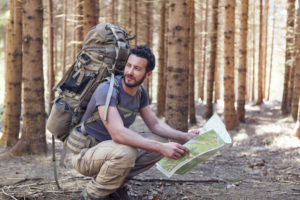One of the saddest songs you’ll ever hear is “Jacob’s Dream” by Alison Krauss, a song I was reminded of recently while reading the chapter “Bending the Map” in Deep Survival by Laurence Gonzales. In it, you meet Ken Killip, who, with a friend, sets out on Milner Pass in Rocky Mountain National Park for a weekend excursion to Rock Lake. Early in the trip, Killup, moving at a slower pace, is separated from his friend. Not a good sign. And not a good friend.
Rather than retrace his steps and head back to his truck, Killip, a skilled outdoorsman and firefighter, continues hiking up what he believes is the correct mountain. It is not. And he’s lost. And what we learn about “bending the map” is that as soon as we start making assumptions about “where” we are, it’s probably a good idea to stop moving or consider turning back home (if you can).
What you don’t want to do is make assumptions. What you don’t want to do is make your situation worse. Fortunately, it turns out for Killip, he takes a bad fall, is forced to stay in place, makes a fire, is sighted by a helicopter, and is saved by boots on the ground.
I remember as a kid, my family and I were sailing home after a week on the boat and suddenly were engulfed by fog. My parents, fearful for the safety of their family, anchored thinking we were just outside of the harbor and could just wait until it lifted. The next morning, with the fog clear, we realized we weren’t even close to the harbor. It happens that fast. And staying in place and waiting for the fog to lift kept us off the rocks.
Similarly, when you fall overboard, the initial jolt makes you want to thrash about, and it’s easy to panic. But the best chance for survival is to simply be calm and float. Sure, it’s easier said than done. But guess what? Guess who has the highest percentage rate for surviving when lost in the woods? Survivalists, mountaineers, ultra-marathoners? No. It’s children under the age of six. Why? Scientists believe it’s because they don’t yet have a mental map of where they are, or what one’s “supposed” to do. They seek shelter, burrowing in the trunk of a tree to stay warm, for example. Unfortunately, it’s children ages seven to twelve with the worst percentage of survival. Why? Because they have some adult characteristics such as mental mapping.
For investors, these scenarios are relevant in times like these. When it comes to investing, “bending the map” is an everyday occurrence. Investors believe they know what they’re doing or that “it’s different this time.” I’ve told you how I feel about artificial intelligence and robo-investing, for example, and how I’m sticking with the four-year-olds. Why? Because in 2012, supercomputers made headlines scanning 10 million thumbnails of YouTube videos learning to identify a cat with 75% accuracy—impressive until you realize an average four-year-old can do it flawlessly.
Action Line: Are you feeling like you’re “bending the map” with your retirement savings? It’s not a great feeling. If you’d like some help navigating markets or becoming a Liberty Retiree, I’d love to talk with you. But only if you’re serious.
E.J. Smith - Your Survival Guy
Latest posts by E.J. Smith - Your Survival Guy (see all)
- Congratulations President-Elect Trump: It Was the Economy… - November 6, 2024
- Congratulations to New Hampshire Governor-Elect Kelly Ayotte - November 6, 2024
- VICTORY: Donald Trump’s Speech at Mar-a-Lago - November 6, 2024
- The 4 Biggest Surprises of the 2024 Election - November 5, 2024
- Fink Wants 800 Pound BlackRock to Get Bigger - November 5, 2024















